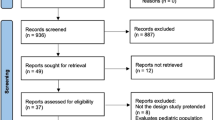Abstract
The purpose of the study was to define the impact of Zenker’s diverticula on voice and potential benefit from repair. Retrospective chart review of prospectively collected data from eleven patients with a Zenker’s diverticulum treated surgically in a tertiary care center from November 2014 through January 2016. The voice handicap index-10 (VHI-10) and eating assessment tool-10 (EAT-10) questionnaires were collected as part of pre- and post-operative evaluation, with an average post-operative follow-up of 69 days. Surgical techniques included: trans-oral endoscopic diverticulotomy with laser assistance, or trans-cervical approach with diverticulopexy or diverticulectomy. The primary outcome was subjective voice improvement. Secondary outcome was swallowing function improvement. Statistical analysis was performed using Wilcoxon Signed-Ranks and Mann–Whitney U tests. In patients undergoing surgical treatment of Zenker’s diverticula, there is a statistically significant improvement (p = 0.001) in patient-reported dysphagia symptoms measured by the EAT-10. There is also a clinically relevant improvement in subjective voice quality (average pre-operative total 6.55, post-operative 2.09, p = 0.022) as measured by the VHI-10. Many patients suffering from Zenker’s diverticula experience subjective voice handicap. Most note improvement in voice quality post-operatively, which we were able to quantify using the voice handicap index. We consider this a relevant consideration in pre-operative evaluation.




Similar content being viewed by others
References
Veenker EA, Andersen PE, Cohen JI. Cricopharyngeal spasm and zenker’s diverticulum. Head Neck. 2003;25:681–94.
Cook IJ, Blumbergs P, Cash K, Jamieson GG, Shearman DJ. Structural abnormalities of the cricopharyngeus muscle in patients with pharyngeal (zenker’s) diverticulum. J Gastroenterol Hepatol. 1992;7:556–62.
Mcconnel FMS, Hood D, Jackson K, O’Connorn A. Analysis of intrabolus forces in patients with zenker’s diverticulum. Laryngoscope. 1994;104:571–81.
Laing MR, Murthy P, Cockburn SW. Surgery for pharyngeal pouch: audit of management with short- and long-term follow up. J R Coll Surg Edinb. 1995;35:315–8.
Yip HT, Leonard R, Kendall KA. Cricopharyngeal myotomy normalizes the opening size of the upper esophageal sphincter in cricopharyngeal dysfunction. Laryngoscope. 2006;116:93–6.
Seth R, Rajasekaran K, Lee WT, et al. Patient reported outcomes in endoscopic and open transcervical treatment for zenker’s diverticulum. Laryngoscope. 2014;124:119–25.
Shahawy S, Janisiewicz AM, Annino D, Shapiro J. A comparative study of outcomes for endoscopic diverticulotomy versus external diverticulectomy. Otolaryngol Head Neck Surg. 2014;151:646–51.
Wilken R, Whited C, Scher RL. Endoscopic staple diverticulostomy for zenker’s diverticulum: review of experience in 337 cases. Ann Otol Rhinol Laryngol. 2015;124:21–9.
Chang CY, Payyapilli RJ, Scher RL. Endoscopic staple diverticulostomy for zenker’s diverticulum: review of literature and experience in 159 consecutive cases. Laryngoscope. 2003;113:957–65.
Bonavina L, Aiolfi A, Scolari F, Bona D, Lovece A, Asti E. Long-term outcome and quality of life after transoral stapling for zenker diverticulum. World J Gastroenterol. 2015;21:1167–72.
Palmer AD, Herrington HC, Rad IC, Cohen JI. Dysphagia after endoscopic repair of zenker’s diverticulum. Laryngoscope. 2007;117:617–22.
Anagiotos A, Feyka M, Eslick GD, et al. Long-term symptom control after endoscopic laser-assisted diverticulotomy of zenker’s diverticulum. Auris Nasus Larynx. 2014;41:568–71.
Belafsky PC, Mouadeb DA, Rees CJ, et al. Validity and reliability of the eating assessment tool (EAT-10). Ann Otol Rhinol Laryngol. 2008;117:919–24.
Rosen CA, Lee AS, Osborne J, Zullo T, Murry T. Development and validation of the voice handicap index-10. Laryngoscope. 2004;114:1549–56.
Arffa RE, Krishna P, Gartner-Schmidt J, Rosen CA. Normative values for the voice handicap index-10. J Voice. 2012;26:462–5.
Acknowledgements
Melissa Mosley, CMA for her assistance in data collection.
Author information
Authors and Affiliations
Corresponding author
Ethics declarations
Conflict of interest
The authors declare they have no conflicts of interest.
Disclosures
The authors declare they have no financial disclosures.
Rights and permissions
About this article
Cite this article
Schoeff, S., Freeman, M. & Daniero, J. Voice Outcomes in Surgical Repair of Zenker’s Diverticulum. Dysphagia 32, 678–682 (2017). https://doi.org/10.1007/s00455-017-9813-3
Received:
Accepted:
Published:
Issue Date:
DOI: https://doi.org/10.1007/s00455-017-9813-3




